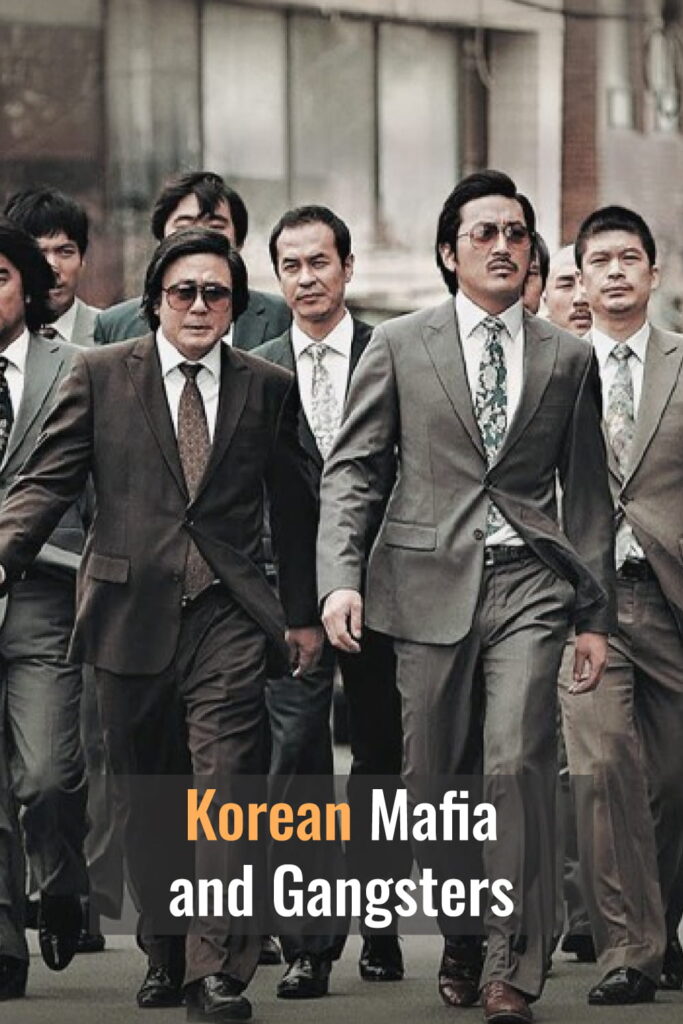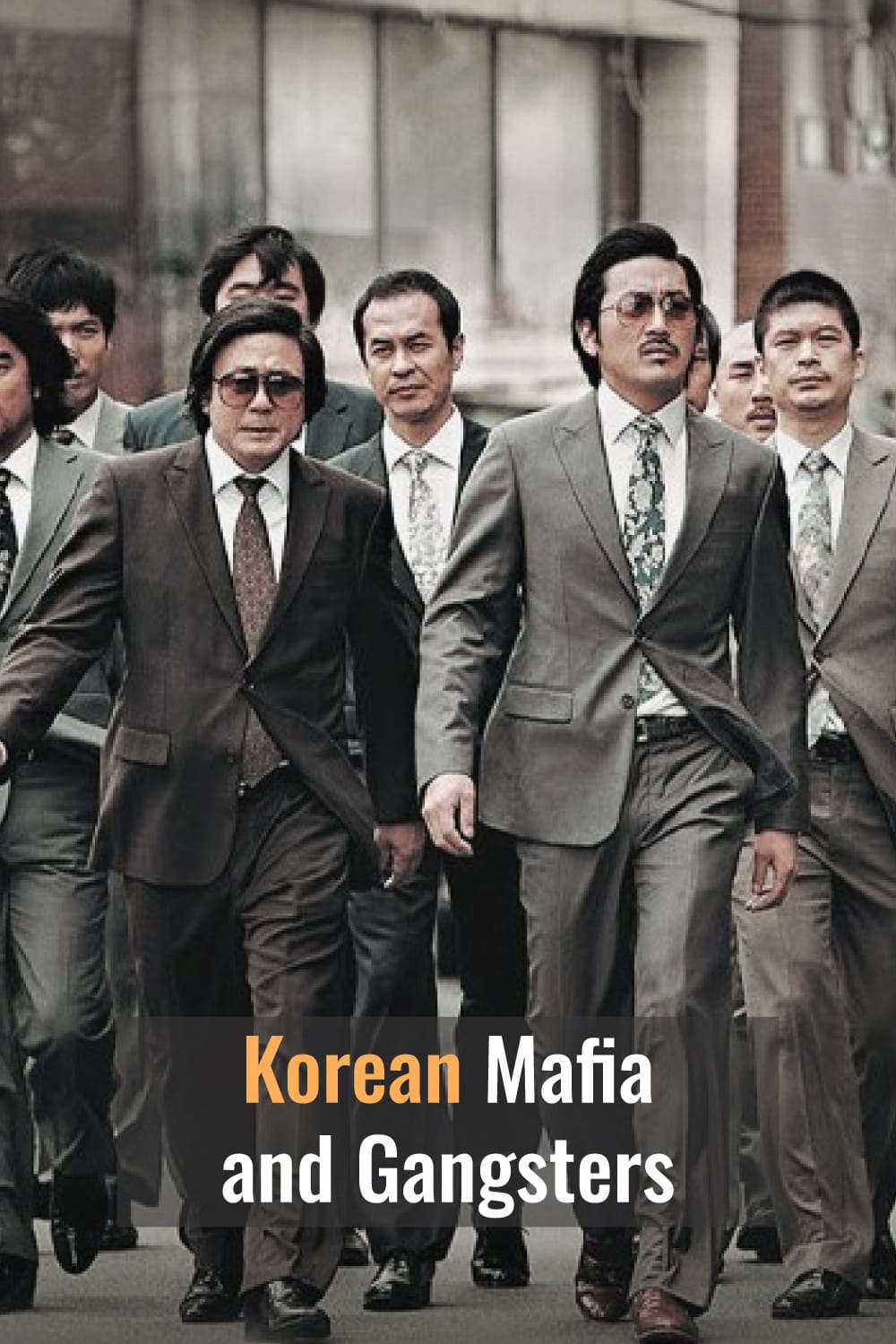From being freedom fighters, tools of oppression, to government representatives, Korean gangsters and mafia groups have worn many hats.
Here are the different types of Korean mafia and gangsters you may encounter.

Key Takeaways
- Iljin: A juvenile delinquent who shows off their social and physical power in groups.
- Yangachi: A punk, thug, or ruffian in Korean, which is used regardless of age.
- Ilsu/Sachae Eopja: A loan shark in Korea.
- Jopok: A mafia in Korean, which refers to organized crime gangs.
Korean mafia is a group of men with violent tendencies who make their living by illegal means, in Korea.
5. Iljin (일진)
Iljin means a juvenile delinquent who shows off their social and physical power in groups.
They’re teenage Kkangpae.
Iljin in middle/high school get scouted to be Jopok later.
High school dropouts with tattoos all over their bodies at Korean juvenile detention centers are usually baby gangsters and pre-Jopok.
4. Yangachi (양아치)
Yangachi means a punk, thug or ruffian in Korean. The term is used regardless of age.
These are the lowest rung on the ladder, more akin to street hustlers.
My Korean friends would often use the term derisively to describe others.
It implies that the person didn’t study hard and makes no productive contributions to society.
They often end up working at gyms, cell phone stores, or used car dealerships. Their words, not mine!
3. Ilsu/Sachae Eopja (일수/사채업자)
Ilsu means loan shark in Korean.
These can be spotted at traditional markets.
You can always tell by their little pocket books. You’ll see their business cards littering the streets at night.
Some do quite well financially.
2. Kkangpae/Ggangpae (깡패)
Kkangpae are a group of people who use violence, engage in misbehavior, and commit misdeeds. It’s used as a vulgar term in Korean.
These are similar to street gangs that dabble in money-making schemes.
1-800-DIAL-A-THUG
Fun fact, bullying gets so bad in Korea that you can hire some thugs to watch your kids on the way to and from school.
Politicians and construction companies also use them to intimidate or break strikes.
My Korean partner has often said that “hiring some thugs” is a viable business strategy in the country.
1. Jopok (조폭/조직폭력배)
Jopok means mafia in Korea, which refers to organized crime gangs. They’re at the top of the food chain in the Korean underworld.
Jopok group names end with pa (branch/faction) at the end.
These are the closest to legit mafia and can be considered the Korean version of Yakuza.
They’re often found throughout the country, but the biggest one is Chilsung-pa based in Busan.
Jopok calls each other Geondal (건달) in the sense that they’re higher/better than Kkangpae. (Some say Geondal is derived from the word Gandharva.)

History of Korean gangsters
Up until the Japanese colonial period, Korea had a rigid class system with royalty and scholars on top, with untouchables such as butchers, ditch-diggers, and criminals on bottom. Criminals were looked down upon by broader society and punished severely when caught.
This changed during the Japanese colonial period when farmers had their lands confiscated and were forced into cities to earn a living. This and the arrival of Yakuza gave rise to Korean organized crime to adapt and resist such forces.
Some early gangsters were considered freedom fighters since they fought against the Yakuza and the Japanese police who often worked together. When local gangsters collided with Yakuza, only Koreans were arrested and sometimes conscripted into the army.
Gangsters became a symbol of struggle against the colonial powers for a time.
Being a successful gangster had a lot to do with hand-to-hand combat skills like boxing and judo. Rival gangs would meet up early in the morning and fight barehanded to establish the pecking order and stop when there was a severe injury. It was a simpler time, with legends such as Hayashi in the 1930s who ended up taking over from his Yakuza boss, Toyama Mitsuru.
Kim Ki-hwan, dominated Jongno, the theatre district of Seoul, and ran the thriving Umikan theatre.
Hayashi lost his influence in 1935, and Kim Ki-hwan was sent to prison, allowing a young thug named Kim Du-han to unify all gangs under him at the age of 18.
When the Japanese were expelled, many of organized crime elements remained in Korea both local and Japanese.
Things changed during the Korean war with local gangs being split into extreme left and right political factions. The first president of Korea famously used right-leaning political gangsters to terrorize opponents.
The aforementioned Kim Du-han was one such tool and later gained a political seat for his heroism and anti-communist activities.
1970s saw the advent of Korean film and the rise of gangsters being portrayed in them. Korean mafia are glamorized in movies much like they are in Hollywood as there’s always interest in the fringes of society.
Organized crime in Korea has evolved over the years to encompass large powerful groups who often reside outside Seoul.
Recently, some gangsters used social media to organize inter-gang meetups where they exchange ideas and cut deals with each other. Sort of like networking for thugs.
Korea has a reputation for being a safe place to travel or live. I can concur after being there for a decade.
There’s still an underworld of organized crime that you might have seen romanticized in Korean media.
In the ten years I lived in Korea, I only encountered Korean gangsters a few times in Yeongdeungpo and at an Itaewon pool party. They were chatty in the latter situation and totally fine to socialize with in small doses. I didn’t take the interaction further than a friendly conversation though.
Overall, as long as you don’t do anything in the grey area of the law, you’ll most likely not see them.
Nevertheless, Korean society largely looks down on criminal activity, more so than in other countries like the US.
FAQ
What is the Korean version of the yakuza?
Jopok are the closest thing that Korea has to the Yakuza. They have the full-body tattoos and hierarchy that one would expect.
How do Korean mafia organizations earn money?
They’re involved in a lot of the same things that organized crime in other countries are. This includes extortion, gambling, smuggling goods, drug trafficking, and adult entertainment as well as legitimate businesses including markets, nightclubs, and bars.
How do Korean mafia recruit new members?
Korean mafia recruit juvenile delinquents, and scout athletes from Ssireum, judo, and wrestling teams.
Who were some prominent Korean gangsters?
Hayashi (하야시) was born in Taedong, Korea in 1909. His family moved to Japan when he was 5. During this time many ethnic Koreans in Japan joined the yakuza to avoid discrimination. Hayashi moved up quickly and worked for the famous Toyama Mitsuru. Hayashi was sent by Mitsuru to run the colonial branch of the yakuza in Seoul.
Kim Ki-hwan was one of the most powerful Korean gangsters during the Japanese colonial period. As a former boxer, he was known as a vicious street fighter. His turf was the Jongno district of Seoul, where Japanese merchants opened bars and adult entertainment venues near theater districts. They needed protection and he was happy to oblige. Kim Ki-hwan was the manager and protector of the famous Umikan Theatre in Jongro.
The most infamous “mobster” during this period was Kim Du-han, the son of a Korean independence fighter and insurgent leader Kim Chwa-chin. He had a rough life like many who turned to crime during that period. After his mother and father were killed, Kim grew up as a beggar and became a member of a local gang named Jumok (“fist”). He rose through the ranks and became known for fighting the yakuza. He was able to unify Korean mobs under his rule at the age of 18. He then became an enforcer of the first Korean president who organized attacks against leftist political opponents. Surprisingly, he was able to get into politics and became a representative in the National Assembly.
What are some prominent Korean mafia organizations?
- Beomseobangpa gang, founded in the 1990s by Kim Tae-chon, one of the most powerful criminals in South Korea.
- Yangeuni Family was founded in the 1970s by Cho Yang-eun, a powerful South Korean crime boss who was famously arrested by the government of the Philippines in 2013.
- Chilsung-pa (meaning Seven Star Mob), known as one of the biggest criminal syndicates in South Korea, the biggest crime syndicate of Busan. Their main source of profit is extortion and blackmail. The movie Chingu (Friend) is based on this organization.
How can you recognize Korean gang members?
You can first spot them by their tacky black suits with flood pants, gakdoogi hairstyle (sides shaved with hair on top resembling a radish), large and stocky build, black luxury cars, prominent tattoos, and regional accents from Jeolla or Gyeongsang province. You’ll also notice a lot of 90 degree bowing while saying “hyungnim” really loud.
Where does the Korean mafia operate?
They’re everywhere in Korea. There’s a presence in Seoul especially in Yeongdeungpo. Most of the largest organizations operate in the Jeolla region, in cities such as Gwangju and Mokpo, with other mobsters operating in Busan and Incheon by the ports.
Subscribe for
exclusive info on Korea
Did we miss anything?
Let us know your thoughts or questions about Korean mafia and gangsters!




